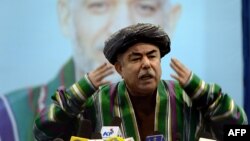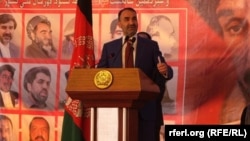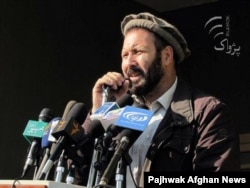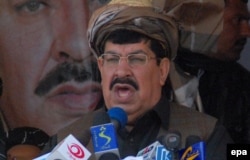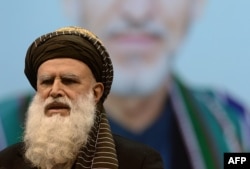Abdul Rashid Dostum appears to be a transformed man. The former warlord turned first vice president now wants to be seen as the mourner-in-chief and the main patron of Afghanistan's beleaguered security forces.
Dostum now spends time visiting the victims of Taliban attacks. He has donated blood for Afghan security forces and has appeared in stylish sports gear to motivate Afghan troops to exercise regularly.
The burly former militia commander, who rose from being a communist foot soldier in the 1980s to one of the leading warlords in the 1990s, has spent a lot of time revamping his image. In nightly news bulletins, he is often seen meeting with tribal leaders, lawmakers and diplomats to cultivate an image of an elder statesman.
Dostum's Junbish-e Milli party attracts a solid vote bank from among fellow Uzbeks in northern Afghanistan. He emerged as a key powerbroker during the 2014 Afghan presidential elections and became vice president after his running mate, Ashraf Ghani, struck a power-sharing deal with his rival Abdullah Abdullah.
Supporters and critics are sharply divided over how much warlords like Dostum have changed from their heyday in the 1990s, when infighting killed hundreds of thousands of civilians. More than 60,000 Afghans were reportedly killed in the capital Kabul, which was completely decimated.
His chief of staff, Enayatullah Babur Farahmand, says Dostum has contributed to establishing democratic institutions based on social justice and equality for all Afghans.
"He had an essential role in defeating the Taliban [in late 2001]. He established the first private TV station for the promotion of freedom of expression," Farahmand told RFE/RL's Gandhara website. "Today, he is one of the real advocates for women's rights, youth, freedom of expression and democracy in Afghanistan."
Dostum, however, has a highly controversial past and has been accused of grave human rights violations.
Thomas Ruttig, co-director of the Afghanistan Analysts Network, a Kabul-based think tank, says Dostum should be viewed as a transformed figure.
"I don’t think that Dostum is really typical of former Afghan warlords because he is the only warlord who has not been [an anti-Soviet] mujahedin leader," he said. "Although he functioned as a warlord in the 1990s when the Taliban became stronger and northern Afghanistan was under his control, he never wanted to separate from the state."
Ruttig says Dostum's participation in last year's presidential election indicates "he is not interested in mainly running a certain region in Afghanistan but wants to influence politics on a central level in Afghanistan."
Dostum’s archrival Atta Mohammad Noor appears to be even more successful in updating his image from that of a marauding commander to a benign ruler.
As the governor of Afghanistan's relatively prosperous northern Balkh Province for more than 13 years, Noor is the only warlord successful in keeping his fiefdom.
Former provincial lawmaker Afzal Hadeed, an ally of Noor's, says the governor supports social justice, open society and prosperity.
"He now wears the best suits and ties and is an urbane person. He supports women's rights and wants them to study and move forward in different aspects of life," he told Gandhara. "He is educated, and so are his children. He wants Afghanistan to prosper and favors [the growth of] civil society."
Noor is the only major warlord to have outlived the reign of former Afghan President Hamid Karzai. While not controlling territory, these former militia leaders still wield considerable influence as lawmakers, officials, business tycoons and politicians.
Hazrat Ali, a member of the anti-Taliban resistance in the 1990s, became a lawmaker in 2005 and was re-elected in 2010. He became a powerful figure among his Pashai community in the 1990s for resisting the Taliban in their mountainous homeland in eastern Afghanistan. He rose to prominence after allying with the U.S. Special Forces to hunt Al-Qaeda leader Osama Bin Laden in late 2001.
Gul Agha Sherzai (real name Muhammad Shafiq) was once one of the most powerful figures in southern Afghanistan and has since attempted a populist revamping of his image.
The former governor didn't resist being asked to leave his home base in Kandahar Province in 2003 and has championed patriotism and reconstruction to brandish his new image. As the governor of eastern Nangarhar Province, Sherzai was dubbed "the Bulldozer" for building roads, bridges and schools. Known as a colorful character, Sherzai prides himself on composing songs.
Ismail Khan, a former warlord in western Herat Province, spent years in Taliban captivity. After considerable Western pressure in the mid-2000s, he left Herat to become the energy minister in Kabul but still wields considerable influence in his home base.
Khan says he hates being called a warlord. "The Americans and English tried to discredit us with that word, until they realized they couldn't do without us in their fight against Al-Qaeda and the Taliban," he told a German magazine.
In an unsuccessful bid during last year's presidential election, Khan teamed up with Abdul Rab Rasul Sayyaf, another major warlord. The pair still wield considerable influence by placing confidants in provincial and central administrations.
Sayyaf, a former Kabul University academic, has positioned himself as the key rival of the hardline Taliban because of his religious credentials and fiery sermons. The Taliban have called him "the manifestation of Satan" and consider him their No. 1 enemy.
Malek Sitez, an Afghan researcher at the Danish Institute for Human Rights in Copenhagen, says that despite the apparent transformation of some individuals, the outlook of Afghan warlords has not changed.
"Their mentality might have modernized, but I don't see any change in their strategic vision," he said. "They still want to have a strong monopoly over power, which can be clearly observed."
Sitez blames the United States and its international allies for reviving warlord power after the Taliban's fall in 2001.
"The international community tried to replace a politico-religious group, the Taliban, [with] democracy," he said. "[But] they chose these warlords as their partners. This was illogical because you cannot implement human rights and democratic values through those accused of grave rights abuses."
Former Afghan Interior Minister Ali Ahmad Jalali says warlords embody the changing power structures in Afghanistan after the Soviet invasion in 1979.
"There were two centers of authority in Afghanistan. The first was the government, and the second was the traditional elite consisting of local elders, tribal elders and local mullahs," he said. "But during the war, a new center of power emerged. Some people gained weapons, money and armed gangs. They empowered themselves to the extent that it eventually created hurdles in restoring peace and stability."
Jalali, a professor at the National Defense University in Washington, D.C., says such informal power structures could have been controlled or coopted through establishing the rule of law and national political parties but Afghanistan failed to do so.
Vishal Chandra, the author of "The Unfinished War in Afghanistan: 2001-2014," argues that the civil war of the 1990s institutionalized factional politics and demolished old structures that had defined the relationship between the Afghan state and society.
"When Karzai took over power [in 2001], he had to rely on some of these informal power structures [warlords] to be able to extend his authority beyond Kabul. He had a huge challenge before him," Chandra said.
Chandra says Ghani now faces similar challenges. "Afghanistan may not casually relapse into a state of total civil war, but at the same time it is logically impossible to think of a stable and peaceful Afghanistan in the near future," he said.
Ahmad Takal contributed reporting from Prague.




